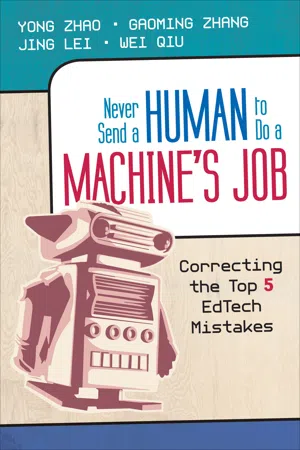
Never Send a Human to Do a Machine′s Job
Correcting the Top 5 EdTech Mistakes
- 144 pages
- English
- ePUB (mobile friendly)
- Available on iOS & Android
Never Send a Human to Do a Machine′s Job
Correcting the Top 5 EdTech Mistakes
About this book
Do what you do best and let technology do the rest
Technology has transformed our lives. Virtually every school and classroom is connected. Why then, has it not transformed education? Consider these five ways educators can begin to optimize classroom technology and rethink its use.
- See technology as a complement rather than a replacement
- Embrace its creation potential over consumption function
- Encourage design and personalized learning over standards and outcomes
- Celebrate the journey toward digital competence over curriculum improvement
- Focus on tech-pedagogy over product usage
Learn how to let technology cultivate student autonomy, creativity, and responsibility while focusing on lessons that hone higher-order and critical thinking skills.
"Dr. Zhao continues to push educators' thinking by taking a serious examination of the role technology has played in education. The struggles he lays out are challenges educators try to overcome on an almost daily bases. The new thinking in this book needs to be read by those in the classroom and leaders alike."
Steven W. Anderson, Author
Content Curation: How to Avoid Information Overload, @web20classroom
This book masterfully address the issues related to technology integration in schools. Dr. Zhao artfully navigates through the misconception of technology as the ultimate solution to the challenges of teaching.
Jared Covili, Author of Going Google and Classroom in the Cloud
Frequently asked questions
- Essential is ideal for learners and professionals who enjoy exploring a wide range of subjects. Access the Essential Library with 800,000+ trusted titles and best-sellers across business, personal growth, and the humanities. Includes unlimited reading time and Standard Read Aloud voice.
- Complete: Perfect for advanced learners and researchers needing full, unrestricted access. Unlock 1.4M+ books across hundreds of subjects, including academic and specialized titles. The Complete Plan also includes advanced features like Premium Read Aloud and Research Assistant.
Please note we cannot support devices running on iOS 13 and Android 7 or earlier. Learn more about using the app.
Information
Chapter One The Wrong Relationship Between Technology and Teachers Complementing in an Ecosystem Versus Replacing in a Hierarchy
Will classroom TV replace teachers?
- Will TV replace teachers?
- Will computers replace teachers?
- Will online education replace teachers?
- Will tablets replace teachers?
An Ecosystem, not a Hierarchy: Reconsidering the Relationship Between Teachers and Technology
A Hierarchy: Displacement Theory and Media Comparison Studies
An Ecosystem: Dancing With Robots and a Transmedia Learning System
Table of contents
- Cover
- Half Title
- Title Page
- Copyright Page
- Contents
- Acknowledgments
- About the Authors
- Introduction
- Chapter One The Wrong Relationship Between Technology and Teachers Complementing in an Ecosystem Versus Replacing in a Hierarchy
- Chapter Two The Wrong Application Technology as Tools for Consumption Versus Tools for Creating and Producing
- Chapter Three The Wrong Expectation Technology to Raise Test Scores Versus Technology to Provide Better Education
- Chapter Four The Wrong Assumptions Technology as Curriculum Versus Digital Competence
- Chapter Five The Wrong Technology Implementation Top Down Versus Bottom Up
- Chapter Six Making It Right Reimagining Education in the Second Machine Age
- Index
- Publisher Note